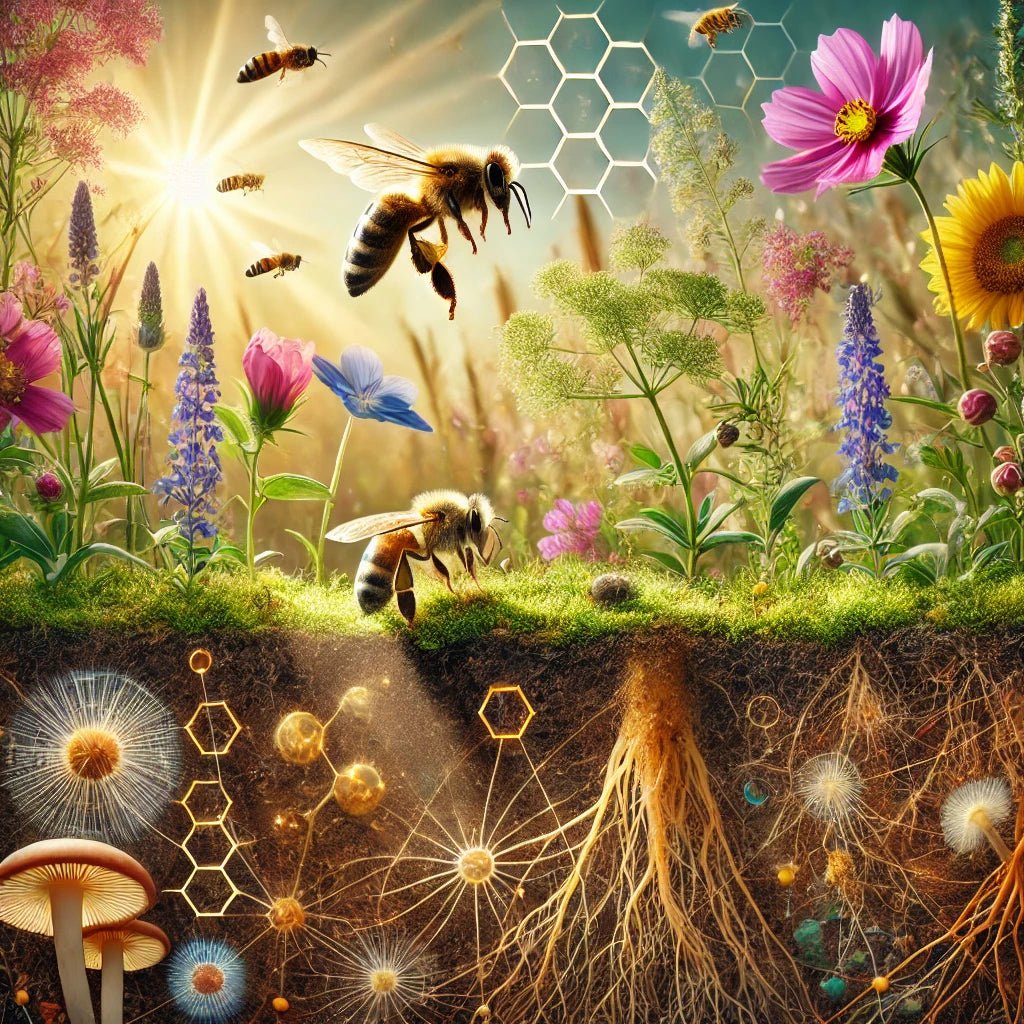Die Natur lebt von komplexen Beziehungen, von denen viele unsichtbar unter unseren Füßen ablaufen. Mykorrhizapilze, die eine symbiotische Beziehung mit Pflanzenwurzeln eingehen, sind ein Eckpfeiler gesunder Ökosysteme. Bienen, die unermüdlichen Bestäuber unserer Welt, spielen eine subtilere, aber faszinierendere Rolle bei der Unterstützung des Erfolgs dieser Pilze. Obwohl ihre Verbindung indirekt erscheinen mag, ist die Interaktion zwischen Bienen und Mykorrhizapilzen ein faszinierendes Beispiel für das vernetzte Netz der Natur.
Was sind Mykorrhizapilze?
Mykorrhizapilze sind eine Gruppe von Pilzen, die Pflanzenwurzeln besiedeln und eine symbiotische Beziehung eingehen, von der beide Organismen profitieren. Die Pilze helfen den Pflanzen, Wasser und Nährstoffe (wie Phosphor und Stickstoff) aus dem Boden aufzunehmen, während die Pflanzen den Pilzen Kohlenhydrate liefern, die während der Photosynthese entstehen. Diese Partnerschaft verbessert das Pflanzenwachstum, die Widerstandsfähigkeit und die allgemeine Gesundheit des Ökosystems, was Mykorrhizapilze zu einem wichtigen Akteur in der Landwirtschaft, Forstwirtschaft und in natürlichen Ökosystemen macht.
Die zwei Haupttypen von Mykorrhizapilzen sind:
- Ektomykorrhizapilze , die eine Hülle um die Pflanzenwurzeln bilden.
- Arbuskuläre Mykorrhizapilze (AMF) , die in die Wurzelzellen eindringen, um Nährstoffe direkt auszutauschen.
Die Rolle der Bienen im Ökosystem
Bienen sind für die Bestäubung von Blütenpflanzen unerlässlich, darunter auch viele, die Mykorrhizapilze beherbergen. Pflanzen wie Klee, Wildblumen und Bäume sind für ihr Gedeihen sowohl auf Bestäuber als auch auf Pilze angewiesen, wodurch eine indirekte, aber wichtige Verbindung zwischen Bienen und Mykorrhizapilzen entsteht.
Bienen beeinflussen den Erfolg von Mykorrhizapilzen, indem sie gesunde Pflanzenpopulationen fördern. Wenn Pflanzen gedeihen, dehnen sich ihre Wurzeln aus und bieten Pilzen mehr Möglichkeiten, sich anzusiedeln und zu wachsen. Ohne Bienen würde die Vielfalt und Fülle der Pflanzen – und damit auch der Pilze, die sie unterstützen – abnehmen.
Der indirekte Zusammenhang: Bestäubung und Bodengesundheit
Bienen tragen indirekt zu Mykorrhizapilzen bei, indem sie:
- Steigerung der Pflanzenvielfalt: Durch die Bestäubung einer Vielzahl von Pflanzen sorgen Bienen für die kontinuierliche Reproduktion blühender Arten. Eine vielfältige Pflanzenpopulation schafft einen reicheren und stabileren Lebensraum für Pilze.
- Förderung von Wurzelnetzwerken: Gesunde bestäubte Pflanzen bilden ausgedehnte Wurzelsysteme, die den Nährboden für die Ansiedlung von Mykorrhizapilzen bilden. Größere Wurzelsysteme bedeuten mehr Verbindungen, die Pilze bilden können.
- Verbesserung der Bodenfruchtbarkeit: Wenn Bienen Hülsenfrüchte wie Klee bestäuben, binden diese Pflanzen Stickstoff im Boden und verbessern so dessen Qualität. Mykorrhizapilze gedeihen in nährstoffreichen Böden und profitieren zusätzlich von diesen Veränderungen.
Bienen und Sporenverbreitung
Eine der weniger bekannten Arten, wie Bienen mit Pilzen interagieren, ist der Transport von Pilzsporen. Mykorrhizapilze vermehren sich über mikroskopisch kleine Sporen, die sich durch Erde, Wasser und manchmal sogar Insekten verbreiten.
Obwohl Bienen nicht direkt auf der Suche nach Mykorrhizapilzen sind, können sie durch ihre Aktivitäten unbeabsichtigt Pilzsporen verbreiten. Wenn Bienen in Blumen graben oder auf dem Boden landen, um Wasser zu sammeln, können sie Pilzsporen aufnehmen und an neue Orte übertragen. Dieser Prozess hilft Pilzen, neue Gebiete zu besiedeln und ihre wohltuende Wirkung im gesamten Ökosystem zu verbreiten.
Gemeinsame Ökosystemstressoren
Sowohl Bienen als auch Mykorrhizapilze sind durch menschliche Aktivitäten ähnlichen Bedrohungen ausgesetzt. Pestizide, Lebensraumverlust und Klimawandel wirken sich negativ auf beide Arten aus und stören ihre wichtige Rolle in Ökosystemen. Zum Beispiel:
- Pestizide: Für Bienen schädliche Chemikalien wirken sich auch auf Bodenpilze aus, verringern deren Populationen und beeinträchtigen die Pflanzengesundheit.
- Lebensraumfragmentierung: Der Verlust von Wildblumenwiesen begrenzt die Nahrungsquellen für Bienen und zerstört die Pflanzen, die Mykorrhizapilze unterstützen.
- Bodenerosion: Intensive Landwirtschaft und Abholzung schädigen die Bodengesundheit und verringern das Pilzwachstum sowie die Pflanzenvielfalt, die für die Erhaltung der Bienenpopulationen erforderlich ist.
Der Schutz von Bienen und Pilzen erfordert einen ganzheitlichen Naturschutzansatz, da beide für die Gesundheit der Ökosysteme von entscheidender Bedeutung sind.
Was können wir lernen?
Die Verbindung zwischen Bienen und Mykorrhizapilzen unterstreicht das empfindliche Gleichgewicht der Natur. Obwohl ihre Beziehung indirekt erscheinen mag, hängt das Überleben des einen von der Gesundheit des anderen ab. Bienen unterstützen die Pflanzen, die Pilze brauchen, und Pilze erhalten die Bodengesundheit, auf die Pflanzen (und Bienen) angewiesen sind.
Diese gegenseitige Abhängigkeit erinnert uns an die Bedeutung der Artenvielfalt und die verborgenen Zusammenhänge innerhalb von Ökosystemen. Indem wir Bienen schützen, schützen wir Pflanzen und Pilze, und indem wir gesunde Pilznetzwerke fördern, schaffen wir die Bedingungen, die Bienen zum Gedeihen brauchen.
Ein Aufruf zum Handeln
Um diese komplexe Partnerschaft zu unterstützen, können wir einfache, aber wirkungsvolle Schritte unternehmen:
- Pflanzen Sie bienenfreundliche einheimische Pflanzen , die die Bestäubung und das Pilzwachstum unterstützen.
- Vermeiden Sie Pestizide , die sowohl Bienen als auch Bodenpilzen schaden.
- Nutzen Sie nachhaltige landwirtschaftliche Praktiken wie Fruchtwechsel und reduzierte Bodenbearbeitung, um die Bodengesundheit zu erhalten.
- Fördern Sie die Pilzvielfalt durch Praktiken wie Kompostierung und Renaturierung erschöpfter Böden.
Die Beziehung zwischen Bienen und Mykorrhizapilzen ist vielleicht nicht sofort sichtbar, aber ihre Auswirkungen sind tiefgreifend. Indem wir diese Partnerschaft verstehen und unterstützen, helfen wir nicht nur Bienen und Pilzen – wir schützen auch die Gesundheit unseres Planeten.
Verweise
- Rillig, MC, et al. (2015). „Wechselwirkungen zwischen Mykorrhizapilzen und Bestäubern im Anthropozän.“ Trends in Ökologie & Evolution .
- Goulson, D. (2013). „Bienensterben im 21. Jahrhundert.“ Nature Reviews .
- Smith, SE, & Read, DJ (2008). Mykorrhiza-Symbiose .
- van der Heijden, MGA, et al. (1998). „Die Vielfalt der Mykorrhizapilze bestimmt die Pflanzenvielfalt, die Variabilität des Ökosystems und die Produktivität.“ Nature .


